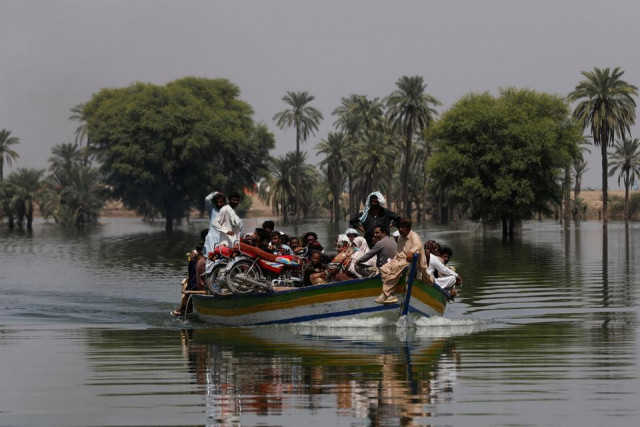A month later, Pakistan’s flood victims continue to flounder
Tens of thousands of victims still live in squalor and disease in flood-hit areas

Under a broiling midday sun, a police officer was handing out lifejackets to a group of desperate passengers before they took a dangerous step to board a boat.
They had to take a 10-minute journey to cross a 15-meter (50-foot) water channel to reach a breakaway portion of the Indus Highway.
Clutching their children and carrying ration bags on their heads, panicked men and women would scramble to find a place in overcrowded canoe boats to cross the channel created after authorities made a cut through a major highway to save this ancient town of Sehwan in southern Sindh province from the torrents of devastating floods in late September.
Others were loading their motorbikes, water cans, and luggage on the boats to cross the tiny distance, which otherwise would cost them an additional 120 kilometres (74 miles) to reach their homes.
Two men holding a young but frail boy were carefully treading through the floodwaters to board the boat.
"Yes, we took him to the doctor," one of them briefly replied in a choked tone as the loud chants of the boat operator forced them to hurry up.
Read more: The disproportionate impact of floods on women
Muddy floodwaters were still covering large swaths of land across the highway even over a month after the massive floods inundated a third of the country.
The cut in the road was made due to the overflowing Manchar Lake in late September, disconnecting Sehwan, home to 175,000 people, from the neighbouring Dadu district.
Located west of the mighty Indus River in the southern districts of Dadu and Jamshoro and spreading over 250 square kilometers (96.5 square miles), Manchar is also one of Asia's largest freshwater lakes. With an average depth of 2.5-3.75 meters (8-12 feet), the lake can expand to 500 square kilometres (193 square miles) during the peak monsoon season.
It otherwise takes only 30 kilometres (18.6 miles) to reach Dadu from Sehwan, but the cut in the road added 90 kilometers (56 miles) to the journey.
“This has become a new normal here. Every day, thousands of people cross this small distance to reach their villages and work," Saeed Ahmed, a police officer who was handing lifejackets to the passengers, told Anadolu Agency.
According to Ahmed, who has been serving here for over a month, some 5,000 people use canoe boats every day to cover the stone-throw distance as laborers backed by heavy machinery were dumping rocks into the 6-8 feet deep water to plug the cut.
"There is no other option but to take a boat to reach Sehwan and look for work and buy groceries as our villages are still under water," said Mahmood Umrani, a local farmer.
A supervisor, who is overseeing the reconstruction work on the road, said it would take "another few days" to repair the road.
"If it is done, we will at least be free from these financial and physical hassles," Umrani told Anadolu Agency.
"Our children and women are sick and hungry. Our people have been going through this risk and hassle every day to take them to the hospital or buy food for them," he went on to say.
'We live in squalor and disease'
Drenching monsoon spells and apocalyptic floods have killed nearly 1,700 people across Pakistan, mainly in Sindh and Balochistan provinces, the two hardest-hit regions.
The cash-strapped South Asian country has also suffered staggering financial losses amounting to $40 billion, mainly in terms of infrastructure and agriculture.
The World Bank fears that the economic backlash inflicted by the super floods might push another 10 million of the country's roughly 230 million people below the poverty line.
Although a large number of victims have started returning to their homes amid receding floodwaters in many areas in the two provinces, tens of thousands are still living in shelter camps and tents.
Perched on the northern bank of Manchar Lake, this dust-bowl tent city in the Laal Bagh area is a temporary home to nearly 5,000 flood victims who are still unsure about their return.
"We are counting the days to leave this place. We are living here in squalor and disease," said Nooran Bibi, a mother of three who hails from Khairpur Nathan Shah town of Dadu district.
The ill-fated town was among the areas that were completely inundated by the massive floods.
Standing in a queue to grab lunch for her children and herself, Bibi along with thousands of others left her village and took shelter at this camp.
"Houses have been flattened, crops have been wiped out, and the entire village is surrounded by waist-deep water," she told Anadolu Agency.
"There is nothing left for us there. I am not sure whether we will return to our village or not," added Bibi, whose husband is looking for work in Sehwan, which according to her is difficult nowadays due to the economic slowdown.
The flood victims, especially in the shelter camps, are already reeling from huge outbreaks of several waterborne eyes and skin diseases.
Every day, according to health officials, several deaths, particularly among children, are being reported from flood-hit regions due to malaria, dengue, gastroenteritis, and cholera.
The Pakistan Medical Association, a nationwide organisation of medical professionals, has already warned that disease outbreaks might kill far more people than by the rains and floods if there is no immediate response.
Catastrophe far from over
A visit to several suburban areas of Sehwan and Jamshoro suggested that the catastrophe is still far from over.
Most of the schools and medical dispensaries on the outskirts of Sehwan have been badly damaged and are no longer operating.
Groups of children were spotted either taking dips in floodwaters or assisting their parents in fetching potable water from nearby water treatment plants.
"(Potable) water has been the biggest issue here. In fact, it's the key reason for many diseases among our children and adults," Mohammad Younas, another flood victim, told Anadolu Agency.
"I and my children have to travel at least half a mile to fetch water from a treatment plant," he added.
A narrow strip of road was the only thing that was not under water during a miles-long journey towards Yousuf Bagh village located on the eastern outskirts of Sehwan.
Large swathes of land on either side of the road were covered in 4-6-foot deep water. Both sides of a nearby railway track were also inundated by deep water.
A few villagers were spotted outside their homes perched on high ground, placing sandbags in an attempt to strengthen their boundary walls.
The water was so high at some points that it lapped over the road as a motorboat carrying a few villagers passed by.
Surrounded by floodwater, the area hospital and school also remained closed.
“It's been over a month. We are still surrounded by water. We cannot do anything except for waiting and praying," said Ali Gohar Mallah, a marooned resident.
"This battered road is our only connection with the rest of the world."


















COMMENTS
Comments are moderated and generally will be posted if they are on-topic and not abusive.
For more information, please see our Comments FAQ